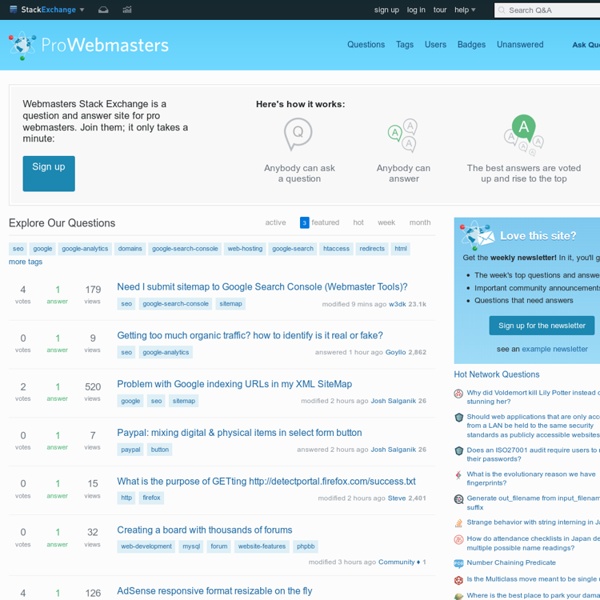



Welcome to Fabric! — Fabric documentation Headscape :: Sitemap demo <div class="info i_error"><div class="info_top"><div class="info_tl"> </div><div class="info_tr"> </div></div><div class="infobox"><h3>Javascript is disabled</h3><p>You need to have Javascript enabled to use the administration features of this site.<br /> Please enable Javascript and try again.</p></div><div class="info_bot"><div class="info_bl"> </div><div class="info_br"> </div></div></div> Site Map Site Structure Hint: Use Ctrl+z to undo a mistake! Headscape CMS4. © 2009 Headscape ltd. | www.headscape.co.uk
PyMT : Open source library for multitouch development Open Blocks download page | Scheller Teacher Education Program This is the download page for OpenBlocks, an open-source Java library for creating blocks-based programming UIs. OpenBlocks consists of two packages: codeblocks and slcodeblocks. Codeblocks is the basic underlying library that is responsible for most of the functionality. We will periodically release updates to this library. UPDATE: We have created a sample Eclipse project using OpenBlocks and attached it below. We also noticed that mikaelhg has started a refactoring branch of this code on github. Support OpenBlocks is no longer under development at MIT STEP (we are focusing our efforts on a new web-based blocks library called ScriptBlocks), but we have created a Google Group for questions and support. Our libraries depend upon (and include) JFreeChart, JCommon, and TableLayout. By downloading this software, you are agreeing to the terms of the license, as follows: Copyright (c) 2009
PHP | Zalog Catalin's portfolio FlippingBook HTML Edition - Flip Book Maker FlippingBook HTML Edition is a set of JavaScript and SWF files running on your HTML page. When a page is loaded, the code contained in these files automatically builds in the flash flip book having such options as: zooming, printing, saving, contents, navigation. Flash Player 8 or above. JavaScript enabled web browser. Internet Explorer 6-7, Firefox 2-3, Safari 2-3, Opera 7-9. User Manual (4.7 Mb) We are going to enhance the documentation based upon your feedback. Independence You are not tied to the other’s servers and per-pages costs. Flexibility The interface can be almost completely customized. Various Content You are not limited to using only PDF or pictures. Memory management In contrast to competitors’ products, the big catalog will not occupy hundreds of megabytes of PC memory. Localization Fully localizable texts. Adaptability Any function (zooming, saving, etc) can be turned off.
The Design and Implementation of Pie Menus There're Fast, Easy, and Self-Revealing. Originally published in Dr. Dobb's Journal, Dec. 1991. Although the computer screen is two-dimensional, today most users of windowing environments control their systems with a one-dimensional list of choices -- the standard pull-down or drop-down menus such as those found on Microsoft Windows, Presentation Manager, or the Macintosh. This article describes an alternative user-interface technique I call "pie" menus, which is two-dimensional, circular, and in many ways easier to use and faster than conventional linear menus. Pie menus also work well with alternative pointing devices such as those found in stylus or pen-based systems. During that time, pie menus have been implemented by myself and my colleagues on four different platforms: X10 with the uwm window manager, SunView, NeWS with the Lite Toolkit, and OpenWindows with the NeWS Toolkit. You can move into a slice to select it, or move around the menu, reselecting another slice.
design rules by Jef Raskin - mprove.de The first principle. When using a product to help you do a task, the product should only help and never distract you from the task. Definition: A gesture is an action that you finish without conscious thought once you have started it. Example: For a beginning typist, typing the letter "t" is a gesture. For a more experienced typist, typing the word "the" is a gesture. Commentary. Rule 1. Commentary. Rule 1a. Commentary. Rule 1b. Commentary. The second principle: An interface should be reliable. Commentary. Rule 2: The system should neither lose your work nor through inaction allow your work to be lost. The third princple: An interface should be efficient and as simple as possible. Commentary. Rule 3. Commentary. The fourth principle: The suitability of an interface can only be determined by testing. Commentary. The fifth principle: An interface should be pleasant in tone and visually attractive. Commentary. Summary. Related Pages
50 Great Examples of Data Visualization Wrapping your brain around data online can be challenging, especially when dealing with huge volumes of information. And trying to find related content can also be difficult, depending on what data you’re looking for. But data visualizations can make all of that much easier, allowing you to see the concepts that you’re learning about in a more interesting, and often more useful manner. Below are 50 of the best data visualizations and tools for creating your own visualizations out there, covering everything from Digg activity to network connectivity to what’s currently happening on Twitter. Music, Movies and Other Media Narratives 2.0 visualizes music. Liveplasma is a music and movie visualization app that aims to help you discover other musicians or movies you might enjoy. Tuneglue is another music visualization service. MusicMap is similar to TuneGlue in its interface, but seems slightly more intuitive. Digg, Twitter, Delicious, and Flickr Internet Visualizations